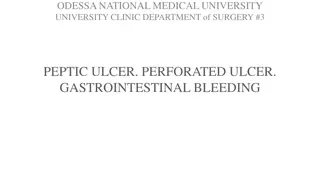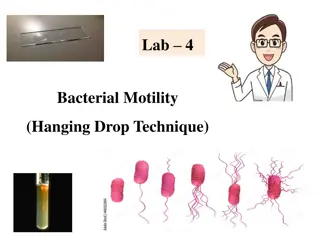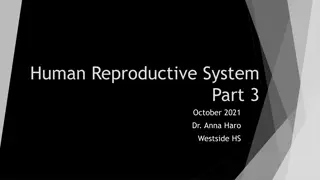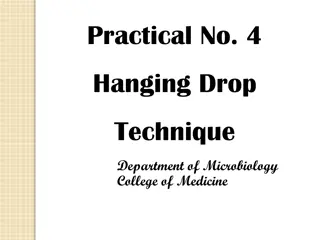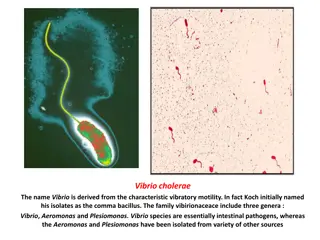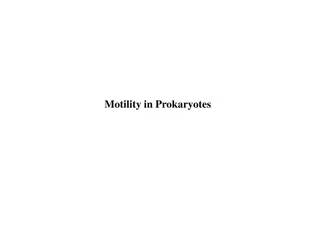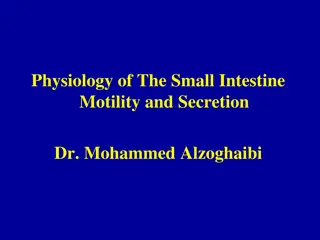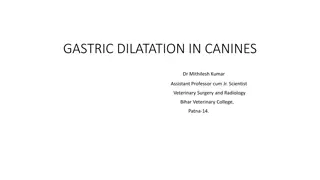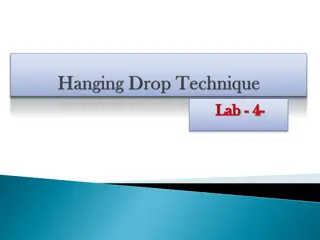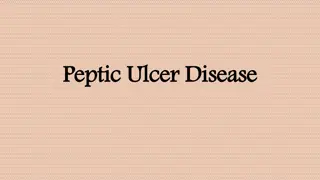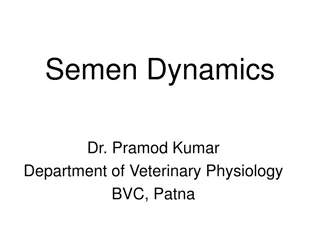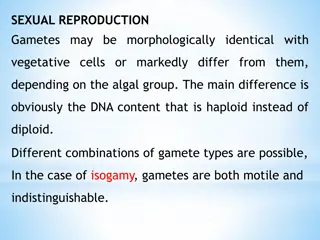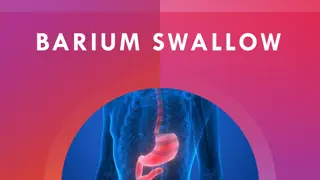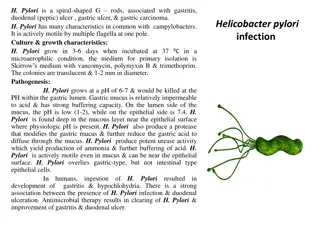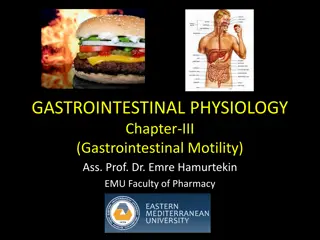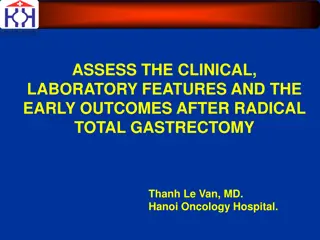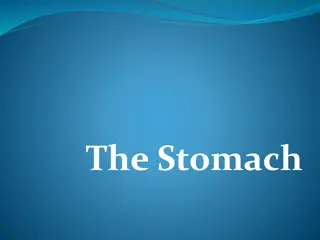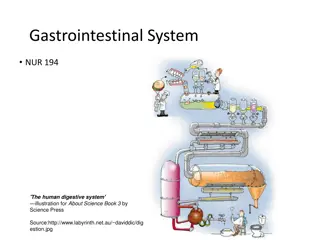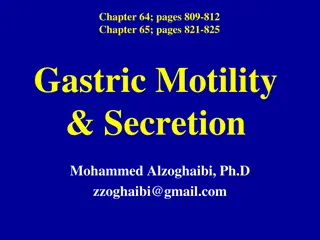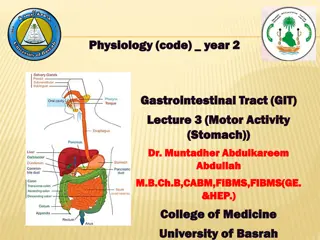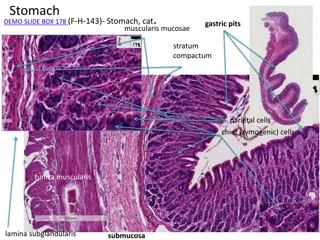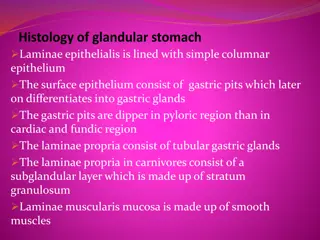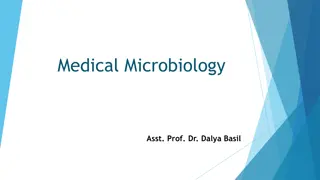Understanding Peptic Ulcer Disease: Causes, Symptoms, and Treatment
Peptic ulcer disease (PUD) involves ulcerations in the duodenal or gastric mucosa caused by factors like Helicobacter pylori infection and NSAID use. Symptoms include abdominal pain and nausea, and treatment often involves H. pylori eradication and proton pump inhibitors to prevent complications lik
0 views • 77 slides
Understanding Bacterial Pathogenesis: Key Concepts and Factors
Bacterial pathogenesis involves the ability of certain bacteria to cause disease by attributes such as transmissibility, adherence, motility, invasion, and toxigenicity. Pathogens can exploit host defenses, while virulence determines the severity of infection. Learn about opportunistic pathogens, no
7 views • 36 slides
Bacterial Motility Testing Using Hanging Drop Technique
The Hanging Drop Technique is a method used to determine the motility of bacteria by suspending them in a drop of fluid on a slide. This procedure involves preparing a hanging drop slide, inoculating the drop with bacteria, sealing it with petroleum jelly, and observing the organisms under a microsc
2 views • 17 slides
Understanding Extracellular Matrix (ECM) and Its Functions
Extracellular Matrix (ECM) is a complex network of proteins, glycoproteins, and macromolecules that provide structural support, regulate cell activities, and play crucial roles in various tissues. It consists of two main types - interstitial matrix and basement membrane, each serving specific functi
12 views • 25 slides
Physiologie Digestive PHASE BUCCALE
Digestive physiology involves the breakdown of food into simple nutrients for absorption by the body. It includes mechanical and chemical means of food degradation using enzymes from salivary, gastric, pancreatic, and colonic bacteria. The digestive system comprises the mouth, esophagus, stomach, li
4 views • 25 slides
What Is Hysteroscopy And How Can It Treat Infertility
If you are facing severe cramps and heavy menstrual periods consistently, or if the gynecologist needs to know more about reproductive health, she might ask you to go for a hysteroscopy surgery. Infertility is a major concern in today\u2019s society. The infertile couples are not able to enjoy the h
4 views • 5 slides
Key Benefits of Gastric Sleeve Surgery for Weight Loss
Choose Healthy Life Bariatrics for gastric sleeve surgery. It is renowned for its effectiveness in promoting significant and sustained weight loss. This procedure limits food intake, reduces hunger, and alters hormonal signals related to hunger and fullness.
6 views • 11 slides
Understanding the Male Reproductive System Physiology
The male reproductive system facilitates spermatogenesis, hormone production, and the physiological processes essential for ejaculation and erection. Sperm cells mature in the epididymis before passing through the vas deferens to reach the seminal vesicle, where they are nourished with nutrient-rich
0 views • 11 slides
Exploring Bacterial Flagella: Structure and Function
Bacterial flagella are long, thin appendages crucial for motility in bacteria. Composed of filament, basal body, and hook, these structures play a vital role in bacterial movement. This article dives into the detailed structure and functionality of bacterial flagella, highlighting their importance i
0 views • 9 slides
Introduction to Hanging Drop Technique in Microbiology
The hanging drop technique is a method used in microbiology to observe living microorganisms suspended in a fluid under a microscope. This technique allows for the examination of motility and morphology of bacteria, providing valuable information for research and analysis. By creating a wet mount us
0 views • 17 slides
Microbiology Study: Hanging Drop Technique in Department of Microbiology, College of Medicine
In the Department of Microbiology at the College of Medicine, the Hanging Drop Technique is utilized to study live microorganisms. This technique involves suspending microorganisms in fluid on a hollow ground slide, allowing for observation of their morphology under a microscope. By creating a wet m
0 views • 8 slides
Overview of Vibrio cholerae: Characteristics and Identification
Vibrio cholerae is a gram-negative, curved rod bacterium known for causing cholera. Its distinctive features include polar flagellum motility, oxidase-positive nature, and resistance to inhibitory substances. Various culture media are used for its isolation and growth, such as transport, routine, an
0 views • 8 slides
Basic Eye Exam and Visual Acuity Assessment - A Comprehensive Guide
Learn about the 5-point eye exam covering visual acuity, gross examination, motility, intraocular pressure, and funduscopy. Understand how to assess visual acuity at different distances, use the Snellen chart, and manage patients with poor vision. Explore techniques for evaluating near vision in pat
1 views • 17 slides
Exploring Motility in Prokaryotes: Flagellar, Spirochaetial, and Gliding Movements
Delve into the fascinating world of bacterial motility through three types of movements in prokaryotes: flagellar movement driven by rotating flagella, spirochaetial movement with flexible axial fibrils, and gliding movement observed in certain bacteria on solid surfaces. Additionally, discover how
1 views • 14 slides
Small Intestine Motility and Secretion Overview
The small intestine's motility and secretion processes involve various types of contractions and movements, such as segmentation contractions, peristalsis, and the migrating motor complex. These processes play a crucial role in mixing chyme, aiding in digestion, and facilitating absorption of nutrie
1 views • 43 slides
Understanding Gastric Motility and Secretion in the Stomach
This content delves into the intricate workings of the stomach, focusing on its motor functions, anatomical and physiological divisions, gastric reservoir, storage and mixing functions, and relaxation reflexes. It emphasizes the key roles of the stomach in storing and preparing food for digestion, a
0 views • 47 slides
Understanding Gastric Motility and Secretion in the Stomach
The stomach plays a crucial role in food processing, acting as a reservoir, preparing chyme for digestion, and facilitating absorption. Divided anatomically and physiologically, it functions as a storage unit and mixing chamber for food. Key motor functions include storage, preparation for digestion
0 views • 49 slides
Understanding Gastric Dilatation in Canines: Causes, Symptoms, and Treatment
Gastric Dilatation and Volvulus (GDV) syndrome, commonly known as bloat, is a serious condition in dogs where the stomach dilates and twists, leading to life-threatening consequences. Large breeds, especially deep-chested dogs, are more prone to GDV. The exact cause of GDV is unknown, but factors li
0 views • 27 slides
Microbiology Lab: The Hanging Drop Preparation
Learn how to prepare living microorganisms for microscopic study using the hanging drop technique. This method involves suspending microorganisms in a fluid and creating a hanging drop on a hollow ground slide, allowing for observation of morphology and motility. Follow step-by-step procedures to ma
0 views • 17 slides
Overview of the Gastrointestinal System and Its Functions
The alimentary tract supplies the body with water, electrolytes, and nutrients through processes like movement of food, digestion, absorption, and circulation. The gastrointestinal tract, starting from the mouth to the anus, is aided by accessory organs for digestion. Functions include motility, sec
0 views • 29 slides
Understanding Peptic Ulcer Disease and Dyspepsia: Causes and Pathogenesis
Peptic ulcer disease and dyspepsia are common gastrointestinal conditions. Dyspepsia presents with upper abdominal pain and may or may not be associated with peptic ulcers. The most prevalent causes of dyspepsia include non-ulcer dyspepsia, GERD, and peptic ulcers. Peptic ulcers account for a signif
0 views • 24 slides
Understanding Semen Dynamics and Capacitation in Mammalian Spermatozoa
Semen dynamics play a crucial role in mammalian reproduction, with capacitation being a key process for sperm fertilization capability. Capacitation involves physiological changes in sperm, leading to the acrosome reaction, crucial for oocyte penetration. As sperm transit through the epididymis, the
5 views • 13 slides
Understanding Algal Sexual Reproduction and Life Cycles
Algal sexual reproduction involves various types of gametes, from isogamy to oogamy, with distinct sizes and motility. Algae exhibit different life cycles like haplontic, diplontic, and diplohaplontic, each characterized by specific mechanisms of meiosis and stages of haploid and diploid phases.
0 views • 24 slides
Comprehensive Guide to Barium Swallow Procedure
Barium swallow is a dedicated test to evaluate the pharynx, esophagus, and proximal stomach. It helps diagnose conditions like dysphagia, obstructions, and motility disorders. This guide covers the indications, contraindications, preparation, contrast agents used, and evaluation steps for the proced
0 views • 13 slides
Helicobacter Pylori: Characteristics, Pathogenesis, and Diagnosis
Helicobacter pylori is a spiral-shaped Gram-negative bacterium associated with various gastrointestinal conditions like gastritis, duodenal ulcers, gastric ulcers, and gastric carcinoma. It exhibits unique characteristics in common with Campylobacters and has specific culture and growth requirements
0 views • 5 slides
Understanding Functional GI Disorders: A Comprehensive Overview
Functional GI disorders encompass a range of conditions affecting the gastrointestinal system, such as irritable bowel syndrome and disorders of the gut-brain interaction. These disorders are characterized by no structural abnormalities but are influenced by factors like motility disturbance, viscer
0 views • 42 slides
Understanding Gastrointestinal Motility: Key Concepts and Mechanisms
Gastrointestinal motility involves various processes like peristalsis, segmentation, basic electrical activity, and the migrating motor complex. Peristalsis is the reflex response to gut wall stretching, while segmentation helps mix intestinal contents and digestive juices. Basic Electrical Rhythm (
0 views • 19 slides
Clinical and Laboratory Features of Radical Total Gastrectomy: Early Outcomes
Assessing the clinical and laboratory features, as well as the early outcomes following radical total gastrectomy is crucial in the management of gastric cancer. This study conducted at Hanoi Oncology Hospital retrospectively analyzed 43 patients who underwent this procedure. The overview includes d
0 views • 27 slides
Understanding the Anatomy and Function of the Stomach
The stomach is a vital organ in the digestive system with functions like food storage, mixing with gastric secretions, and controlling chyme delivery to the small intestine. It has a J-shaped structure with various parts like the fundus, body, antrum, and pylorus. The lesser and greater curvatures,
0 views • 21 slides
Understanding the Human Digestive System
The human digestive system is a complex pathway that starts from the mouth and ends at the anus, involving various organs like the mouth, pharynx, esophagus, and stomach. Each part plays a crucial role in breaking down food particles, absorbing nutrients, and eliminating waste products. From chewing
0 views • 132 slides
Overview of Stomach Surgery and Treatment Options
The stomach plays a crucial role in digestion and is divided into four regions - cardia, fundus, body, and pyloric part. Understanding the anatomy of the stomach is essential for surgical interventions, including treatment for benign and malignant gastric diseases like peptic ulcer disease. Surgical
0 views • 30 slides
Gastric Motility and Secretion in the Stomach: Functions and Division Overview
The stomach plays crucial roles in food storage, chyme preparation, water absorption, and slow emptying into the small intestine. Its motor functions include maintaining a reservoir, mixing food, and facilitating relaxation reflexes for optimal digestion. Anatomically and physiologically, the stomac
0 views • 46 slides
Understanding Gastric Motility and Function in the Gastrointestinal Tract
The stomach plays a crucial role in digestion, from storage and mixing of food to slow emptying of chyme into the duodenum. Gastric motility involves peristalsis and retropulsion, essential for propelling food towards the pylorus. Dr. Muntadher Abdulkareem Abdullah provides valuable insights into th
0 views • 13 slides
Various Stomach Anatomy Slides of Different Animal Species
Explore a series of detailed histological slides showcasing the stomach anatomy of different animal species including cats, rabbits, dogs, pigs, sheep, and goats. The images highlight key features such as gastric pits, mucosal layers, chief and parietal cells, proper gastric glands, cardiac and pylo
0 views • 29 slides
Overview of Gastrointestinal Secretions and Structural Considerations
In this informative presentation by Assistant Professor Dr. Emre Hamurtekin, the focus is on gastrointestinal secretions including salivary, gastric, pancreatic, biliary, and intestinal fluids. Structural considerations such as the surface area for absorption, sphincters, villi, and crypts are discu
0 views • 33 slides
Understanding Gastrointestinal Agents: Acidifying Agents, Antacids, Saline Cathartics
Gastrointestinal agents such as acidifying agents, antacids, and saline cathartics are used to manage gastrointestinal disturbances. Acidifying agents like Hydrochloric Acid aid in gastric digestion, while antacids help reduce gastric acidity. Saline cathartics are used as laxatives. Achlorhydria, a
0 views • 36 slides
Structure of Gastric Mucosa in Glandular Stomach
The glandular stomach features laminae epithelialis lined with simple columnar epithelium, leading to differentiation into gastric pits and glands. The laminae propria houses tubular gastric glands, while the laminae muscularis mucosa is composed of smooth muscles. Different regions exhibit distinct
0 views • 14 slides
Understanding Helicobacter pylori: Morphology, Pathogenesis, and Identification
In this detailed lecture, Assistant Professor Dr. Dalya Basil discusses the characteristics, identification methods, growth characteristics, and pathogenesis of Helicobacter pylori. This spiral-shaped, gram-negative rod bacterium is associated with various gastric conditions, including gastritis, ul
0 views • 23 slides
Comprehensive Overview of Oesophageal and Gastric Cancer: Roles and Statistics
This content delves into Oesophageal and Gastric Cancer, exploring statistics, risk factors, common signs and symptoms, and the role of Oesophago-Gastric Clinical Nurse Specialists. It highlights the prevalence, age factors, survival rates, and key risk factors such as smoking, alcohol, and diet. Th
0 views • 6 slides
SWAG Network Oesophago-gastric Cancer Research Update
SWAG Network Oesophago-gastric (OG) Cancer Clinical Advisory Group provided a research update on Upper GI Cancer Studies, National Recruitment data, and Regional Recruitment trends in the UK. The update included information on open cancer studies, sample sizes, recruitment statistics, and participat
0 views • 16 slides
